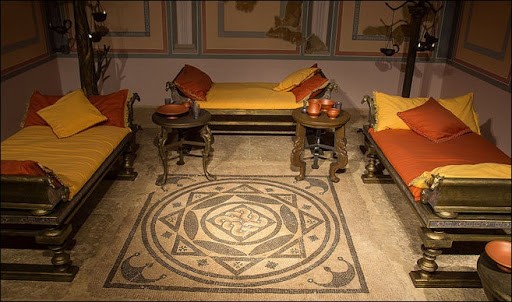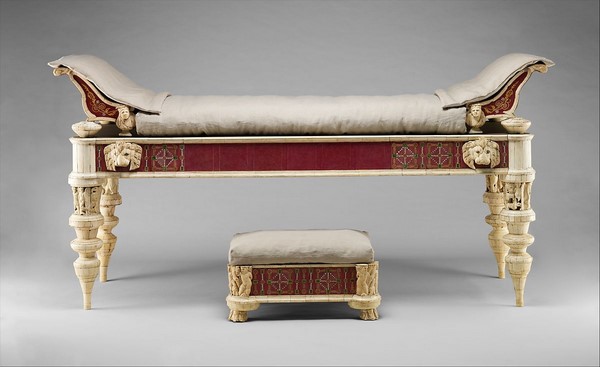What was it like to live in an ancient Greek house? What was ancient Greek life like? The ancient Greeks kept themselves busy and there were plenty of chores, distractions, and entertainments available to keep daily life varied. Ancient Greece had a warm, dry climate, as Greece does today. Most people lived by farming, fishing, and trade. Others were soldiers, scholars, scientists, and artists. Greek cities had beautiful temples with stone columns and statues, and open-air theatres where people sat to watch plays. Shopping in the markets of the agora, performing jury service, watching sporting events, or listening to the latest play kept the Greeks out of the house. There might, too, be religious rituals to watch, processions to see, and drinking parties to attend. In the last article, we examine all the things the ancient Greeks got up to on a regular basis as well as related by looking at their furniture and style that inspired the designers of the late 18th and early 19th centuries. Now we have come to the last part of “The History of Furniture: Ancient Egypt, Greece, & Rome (3/3)”
ANCIENT ROME
What kind of furniture did the Romans have?
Roman furniture was made of stone, wood, or bronze. Villas were largely open to the air, and stone benches and tables were common. Wooden furniture has not survived, but bronze hardware for such furniture is well-known. Buffets with tiers of shelves were used to display silver. The Republic of Rome, later known as the Roman Empire, can truly be said to be the birthplace of our modern civilization. Most legal systems today are based on Roman law; Roman art, sculpture, and literature are still enjoyed to this day, and most European languages are based on Latin. The Roman genius for building and holding together an empire brought an orderly system of government to lands far and wide, creating a world where artists, craftsmen, designers, and scientists could exercise their talents in peace and prosperity.
Furniture in Roman houses tended to be sparse since the occupants liked space and simplicity in their decor. Beauty was created by mosaics, frescos, and water features, and other features of Roman interiors rather than by the use of elaborate furnishings. However, the few items of Roman Empire furniture were elegant and costly, using excellent materials and craftsmanship. Pictures of ancient Roman furniture painted on frescos and other artworks, together with the few pieces still in existence today, have made it possible to reconstruct with accuracy the furniture in Roman times.
Much furniture that we take for granted was entirely unknown to the Romans. No mirrors hung on their walls. They had no desks or writing tables, no dressers or chiffoniers, no glass door curio cabinets for the display of bric a brac, tableware, or books, no mantles, no hat racks. The main items of Roman furniture found in the best houses were couches or beds ( lectus ), chairs and stools, tables, and lamps. Adding chests or wooden cabinets with doors, an occasional brazier, and still seldomer, a water clock, we have assembled everything that can be called furniture, except perhaps for tableware and kitchen utensils. However, this does not mean that Roman furnishings were dull and dreary. If we take into account the decorations, the showy display of the atrium, and the singular beauty of the peristylium, it is clear that the Romans put importance on a very few exquisite and expensive pieces rather than attempting to fill up rooms with just this and that.
Furniture was an important part of functional life and fashion in nearly every settled society, and ancient Rome was no exception. The Romans took their home lives very seriously and used their furniture to reflect their identity as Romans and their place in the Roman world. We don’t always take time to appreciate Roman furniture, but together, the ancient Romans and Greeks laid the foundation for Western culture, so it shouldn’t be a surprise to learn that much of their furniture was similar. Roman furniture was essentially Greek in character, with some notable influences from the Etruscan civilization of Tuscany.
Our knowledge of ancient Roman furniture is based on a few factors, such as materials. Romans made their furniture from wood, metal, or stone (generally marble). Obviously, more examples of marble furniture have survived than wooden furniture.
Since higher-quality materials were owned by the wealthy, we do know more about the furniture of the rich than of the poor. There are, however, exceptions. In 79 CE, the volcano named Vesuvius blew. The sudden eruption buried the nearby towns of Pompeii and Herculaneum, preserving materials like wood that would have eroded, giving us a glimpse into Roman life, uninterrupted by time. Most of our best examples of Roman furniture came from these excavations.
Fun facts that we haven’t brought up in the last article about ancient Greek furniture is reclining and dining in ancient Greece started at least as early as the 7th century BCE. It was later picked up by the Romans.
They ate lying down while others served them. It was a sign of power and luxury enjoyed by the elite. People further down the social ladder copied the laid-back dining style if they could afford to.
But not everyone was so lucky in ancient Greece. You see, women didn’t generally get invited to banquets except for rare occasions like wedding feasts. Even then they had to sit upright. It was only in ancient Rome that customs changed, allowing upper-class women to lounge alongside men. But all that lying down and eating can’t have been good for the heartburn. Elite Greeks and Romans reclined to dine, and ordinary people copied them when they could. Although the practice seems strange to us, it must have been both comfortable and convenient, since reclining during meals spread throughout the Mediterranean and survived for over a millennium!
We have completed the last part of “The History of Furniture: Ancient Egypt, Greece, and Rome” stay tuned for our next article still on the same topic about the history of furniture but at different times. Can you guess what time age that we are going to discuss next? Drop your comments below. In Kaliuda Gallery, you can custom various furniture & home decorations. We are one of the best Bali furniture stores and antique galleries with the best quality and service.




